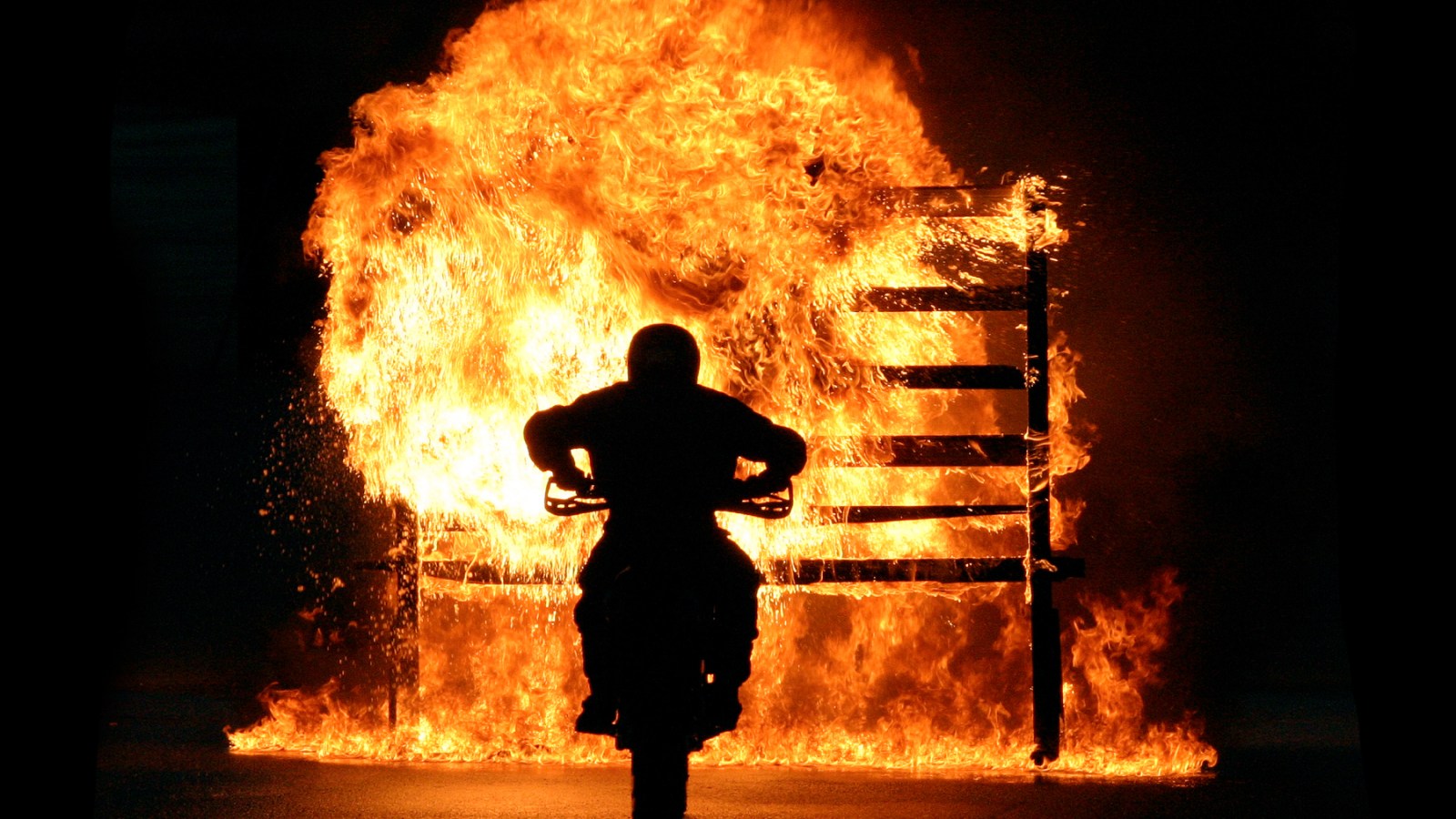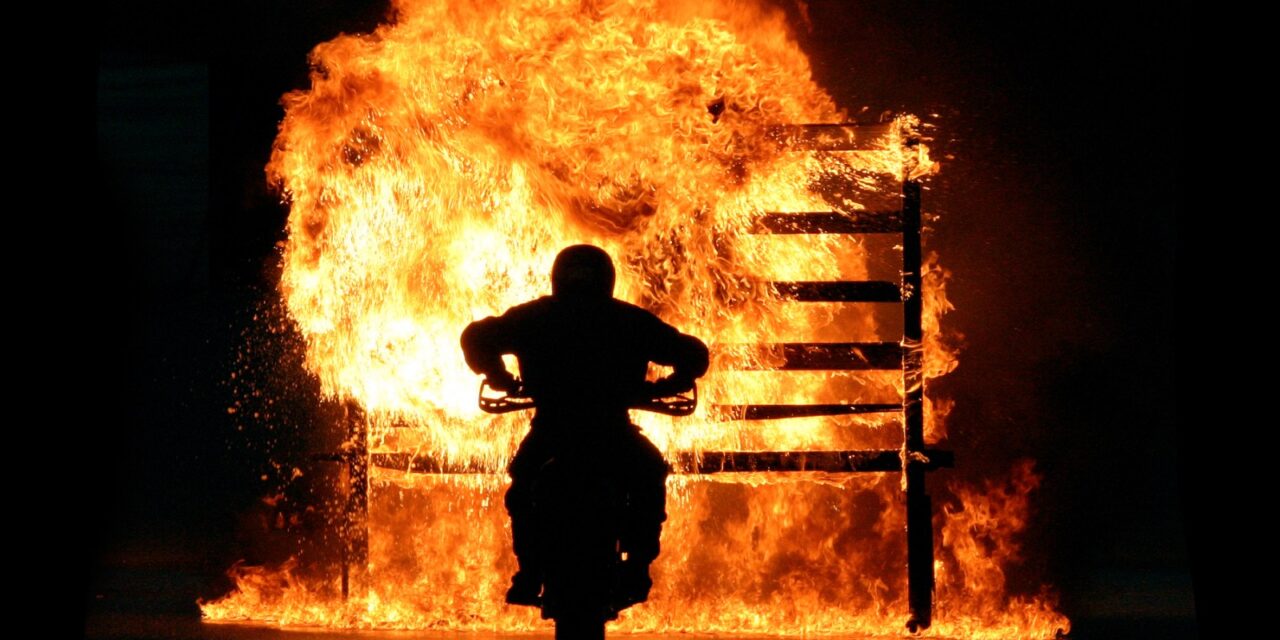
Actor Jason George was a few years into his career when he secured his first starring role in a movie. It was the early 2000s, and he’d been cast as a co-lead in a mountain climbing flick called The Climb. He was excited for the prospect of a break until he walked into a trailer one day and saw a white man “wearing my wardrobe, my helmet, my climbing harness, and they’re putting makeup on him to make him look like me.”
George, who is Black, was stunned.
“I did a double take — if you’d shot it for a movie, [my reaction] would’ve been too much, too big,” he tells Rolling Stone. “I stepped out to make sure I was in the right place, came back in, and said, ‘What is happening?’ And they said, ‘This is your stunt double.’”
What George had walked in on was a “paintdown.” It wasn’t blackface in the traditional sense of a minstrel show, but it was also definitely blackface. One of Hollywood’s many seedy little secrets, a paintdown is when the skin of a white stunt performer is darkened so they can double for an actor of color — rather than just hiring a stunt performer of the same ethnicity.
George says he immediately went to the movie’s producers. He learned that they’d made a few calls to find a Black double for him, but claimed they couldn’t get anyone. “I had to hold all the anger down,” he remembers. “They’d known the lead of their mountain climbing movie was African American since the script was written, long before I was even cast. And it was just four or five calls that got made? It didn’t compute in my head.”
George insisted they make those calls again. Sure enough, the producers soon found a suitable Black double in Mike Freeman, a seasoned climber with an exceptional pedigree (check the many raves about him on mountain climbing message boards). “He ends up the best stunt climber in the whole movie,” George says. “He’s doing stuff the young guys wouldn’t touch. We built this fake mountain and he’s running straight off the end of it so the rope snaps him in mid-air and slams him into the bottom of the thing. He’s loving it.”
In 2001, not long after filming The Climb, George shared this story in a particular setting: a SAG-AFTRA contract negotiation (both stunt performers and coordinators belong to SAG). Ending paintdowns was on the agenda, but when the subject was broached, the response from the Alliance of Motion Picture and Television Producers (AMPTP) was firm: “This isn’t the 1950s,” George says, paraphrasing the AMPTP’s response. “That doesn’t happen anymore. This isn’t a real problem.” George stepped in to explain how he’d just seen it first-hand; not long after, the two sides inserted new language into the contract. Paintdowns were declared “improper” and producers, SAG, and stunt performers were to continue discussing the issue.
In the 20-odd years since, paintdowns and “wiggings” — a similar practice where, instead of hiring a stuntwoman, a man is dressed up to double a woman — have been on the decline, but they’re far from eradicated. The fight itself dates back to the 1970s and the work of pioneering Black stunt performers Jadie David and Marvin Walters; part of a 1983 SAG contract spoke to the importance of matching the gender and ethnicity of actors and their stunt doubles. But even as SAG-AFTRA adopted stronger language to specifically address wiggings and paintdowns, loopholes remained, and people remained willing to exploit them. (Actress Anjelika Washington revealed that she was doubled by a painted down stunt performer on a TV show in 2017 — and shared a harrowing photo to prove it.) This seriously hindered opportunities for stuntwomen and performers of color, especially those just starting their careers.
Finally, though, a dedicated group of stunt performers and SAG allies have zeroed in on new contract language, and an accompanying consultation process they believe will end unnecessary wiggings and paintdowns. These items have already been approved by SAG and the AMPTP, one of just a handful of issues the union and studios have agreed upon as SAG strikes for a fair contract. (The new language hasn’t gone into effect yet as it is part of the contract SAG is still negotiating with the AMPTP.)
The changes to the contract are small but significant, explains Mikal Kartvedt, a longtime stuntman and coordinator who helped write the new language. The first part stipulates that stunt coordinators no longer “shall endeavor,” but “must endeavor” to find stunt performers of the appropriate ethnicity and gender. The second transforms a relatively weak SAG “waiver process” into a much more robust “consultation process,” bolstered by a new layer of studio accountability.
“It will hold people accountable,” says stuntwoman Crystal Santos, who helped spearhead a 2020 effort to end the practices. Under the old guidelines, coordinators would have to show they did their due diligence to find a stunt performer with the right skill set who was also the appropriate race, ethnicity, or gender — but there was typically enough wiggle room to do the bare minimum of outreach and get the waiver anyway. Even if a waiver wasn’t obtained, the consequences were just a SAG violation. Santos believes the internal union threat “deterred some,” but “not enough, because they’re part of SAG and felt entitled.”
The new consultation process, though, “has some teeth,” says Kartvedt. “You call SAG Stunt and Safety and you explain to them why you think you need to conduct a paintdown or wigging. And if you present enough documentation to back yourself, then go with God — safely shoot your gag [industry parlance for ‘stunt’]. However, in almost all instances, SAG will then step in and help you find the appropriate stunt double for the job.”
“If you’re really just trying to give your buddy some hours, or help your friend make their health insurance, that’s not going to work”
Jason George
George is equally confident that these consultations will make wiggings and paintdowns “very rare,” especially with the myriad resources available to find suitable performers. And if they do occur without a consultation, then both the studio and the stunt coordinator are culpable for violations. If a particular stunt coordinator keeps getting a studio in trouble over what are arguably civil rights violations, experts say, then their work opportunities are likely to dry up fast.
“Stunt coordinators, even the unscrupulous ones — I’ll just say that politely — are cognizant and careful when it comes directly from the producers and studios,” Santos says. “Because that could mean the difference between losing one [or] all of their shows.”
Why would big Hollywood studios be willing to take on a little extra liability on this particular issue? George half-jokes because it costs them nothing. “When it’s not money, they can be persuaded about what’s right and wrong, because they’re human beings,” he says. “When it’s money, they become Scrooge McDuck.”
Money, of course, isn’t just a concern for studios and producers. Santos says there’s been plenty of “nastiness” over the push to end wiggings and paintdowns because it ultimately boils down to money, too. She recalls asking an “older, Caucasian, male stunt performer,” why he did paintdowns, and his response was that he needed to feed his family and qualify for health insurance.
“My answer to him was, ‘Don’t you think that the people of color want that too, and should have had that?’” Santos says. “I’ve seen a lot of older performers of color who don’t have the pensions their Caucasian peers have, because they were denied opportunities, and they’re hurting very much in their old age.”
Kartvedt adds that “expanding the pipeline of opportunity for stunt performers of color, women, LGBTQ and people with disabilities” is a big objective in the fight to not just end wiggings and paintdowns, but potentially reshape the stunt profession. There are currently about 4,600 registered stunt performers in SAG-AFTRA, but the industry is dominated by a few hundred people, many of whom are members of, or associated with, a handful of private stunt groups.
These groups tend to only be open to established, accomplished stunt performers who reach certain membership criteria. They are also largely gendered with specific groups for men and women, though men’s groups have started letting in some women in recent years. The benefits to belonging are obvious: a strong support network and consistent work (including some of Hollywood’s biggest jobs). But they can also be extremely cloistered, self-serving, and not very diverse.
“I’ve seen a lot of older performers of color who don’t have the pensions their Caucasian peers have, because they were denied opportunities, and they’re hurting very much in their old age.”
Crystal Santos
Santos was part of a group, United Stuntwomen’s Association, early on in her career, and calls it “one of the biggest mistakes of my career.” When she was a member, in the early 2000s, she says the benefits the female groups provided paled to what the male groups could offer.
“At least when I was there, they weren’t teaching you how to be a stunt coordinator, they weren’t teaching you how to be a director, they weren’t teaching you set etiquette,” she says. “There was nothing notable to promote your career that you would see in the men’s groups. Those have very organized mentoring programs with each other, getting everybody to that stunt coordinating level and second-unit director level.”
Capping it all off was a fight over paintdowns: “They sat there, they tried to convince me to be okay with paintdowns. This is how I ended up leaving the group. They had members doing paintdowns and I tried my best to explain to them that they don’t understand that this is wrong. And they don’t understand why we can’t do paintdowns — or even the definition — so let’s have a SAG representative come and speak to us. They refused. It ended up with me sending a legal letter of quitting.” (The United Stuntwomen’s Association did not immediately return Rolling Stone‘s request for comment.)
Ashlei Tave, a stuntwoman who’s doubled for stars like Gabrielle Union, Tiffany Haddish, and Shari Belafonte, has seen how these groups can function under the best circumstances. She’s associated with the International Stunt Association (ISA), which she says boasts more diverse membership than some of the other groups, and has taken strong stances against wiggings and paintdowns.
She recalls an incident that occurred when working with an ISA-affiliated stunt coordinator on a TV show. She claims the fight coordinator had tried to bring in a white woman behind the stunt coordinator’s back to double the actress Tave was already doubling in a fight scene. The stunt coordinator stepped in to stop it, she says, and when the fight coordinator was asked why he thought the white woman was appropriate for the job, Tave says he replied: “Oh, well, she’s Italian, she tans well.”
The flip side, Tave acknowledges, is that groups can be very “clique-y.” Noting that earlier this week, many of the major stunt groups united for a big SAG strike motorcycle ride, she says: “It was the first time I saw all the groups come together like nothing else mattered. But it was the complete opposite of what happens when productions are running.”
To that end, as Kartvedt ruefully quips, when a grouped coordinator is putting together a stunt team, the “bare minimum” of their labor force search is “call your buddies.”
A call sheet for a network TV procedural obtained by Rolling Stone offers a glimpse into the more flagrant kinds of support these groups can provide. For a car chase scene, the stunt coordinator needed to hire several drivers; a few would be doubling as police officers, while others were needed for “nondescript stunts,” also known as “ND stunts.” Where a “descript stunt” means a stunt performer is specifically doubling an actor, nondescript stunts can be done by anyone. They are essentially background action, with George offering this description: “When the aliens come and you need hundreds of people to run from the explosions — that’s an ND stunt.”
ND stunts are a great way for young performers to develop their skills, resumes, and rolodexes (and, of course, make some money). Yet on this network procedural, the ND driving stunts were performed by seasoned stunt performers and coordinators.
A call sheet for a different episode of the same procedural even showed evidence of a paintdown, when a white female was hired to double for a young Latino boy. For obvious safety reasons, it’s not uncommon for petite adult women to double for young children, including boys. But that doesn’t explain why a Latino woman wasn’t tapped for the stunt.
(Rolling Stone reached out to several other major stunt groups — including Brand X, Stunts Unlimited, Stuntmen’s Association of Motion Pictures, Stuntwomen’s Association of Motion Pictures, and V10 — for interviews, but those requests were not returned.)
Under the old SAG guidelines, safety — the biggest concern in the stunt community — was often cited as a reason why a wigging or paintdown needed to occur: This particular performer is the only one available who can do this stunt. Kartvedt calls this “merely an excuse to cloak discriminatory hiring practices,” while George diplomatically describes it as an “out.” What makes the new consultation process so “elegant,” George argues, is that it forces a conversation that negates the old wiggle room without undercutting safety concerns.
“If you’re telling me this is the most amazing, impossible stunt ever, only two people on the planet can do it, and they’re both working right now, then maybe we can have a conversation about you hiring somebody of a different ethnicity or gender,” he says. “But if you’re really just trying to give your buddy some hours, or help your friend make their health insurance, that’s not going to work… If you can explain how you think four calls was enough for the lead of your movie, then good luck to you — but pretty much anybody in the world will call bullshit on you. You didn’t put in the work.”
Despite the significance of these changes, there is one eerie irony simmering beneath this win for inclusion in the stunt world. Like other non-stunt SAG members — as well as their comrades on the WGA picket lines — artificial intelligence is a legitimate threat to stunt performers. Just as studios appear eager to scan actors and pay them a one-time fee to use their likeness in perpetuity, the studios are interested in capturing basic stunt work to be used again and again. While insulated hiring practices may have been keeping young performers from cutting their teeth with ND stunts in the past, now a computer might be coming for those jobs.
As George explains, ND stunts are “the stunt equivalent of being a background actor. And that’s the perfect spot that, right now, technology says, if I have a scan of you, I don’t need to hire you to do those ND stunts ever again. We’ll just plug them in with digital doubles and we’re good.”
Santos concedes that at least the AI issue has opened the eyes of some folks in the stunt world to the hurdles performers of colors have faced for decades. “We have been fighting for the right to have the jobs we’re qualified for, instead of being told that this Caucasian man or woman can do it better with no evidence. Now we’re facing AI. As I’ve explained to some of my peers, ‘Welcome to what people of color have been fighting against.’ You’re going to be replaced, even though there’s no evidence AI is better than you.”
She adds with a dry laugh, “I was just at a stunt event and one of the Black stuntmen said, ‘Well, now we get to fight fake Caucasian people trying to replace us. Great!’”




